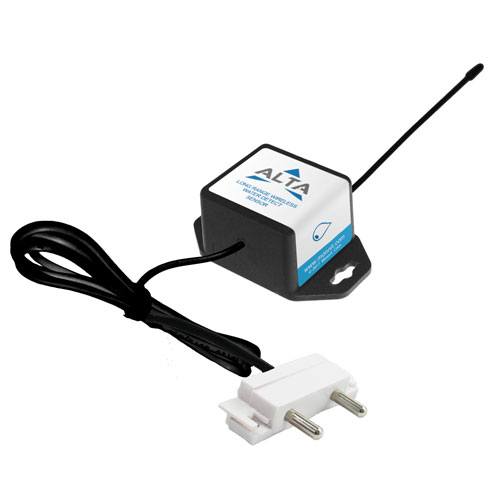Peace of Mind for Your Customers. Less Product Loss for You.
Monitoring your chilled or frozen inventory for optimal temps has never been easier.
Effortless protection & compliance
Monitoring your commercial refrigeration unit's temperature has never been easier now that you can remotely monitor performance with Monnit sensors. The FDA Food Modernization Act (FMA) has strict guidelines regarding the safety of food storage. All Monnit sensor automatically log their data readings so staying compliant with health regulations is as easy as looking at your phone.
All Monnit devices remotely monitor and report data to a digitally logged HACCP compliant record. Installing a wireless sensor is the best way to achieve satisfactory ERES and CFR21 part 11 requirements.
If you're worried about your refrigerator or freezer failing while you're not around Monnit wireless sensor will help ease that anxiety with automatically recorded data and alerts delivered right to your phone.
And the best part, it's more afordable than you think!

Text and email alerts when temperatures fall out of acceptable ranges.
An Edge for Keeping Your Inventory at Optimal Temps
Know it's safe anytime, anywhere
Temperature
 The principal purpose of a refrigerator or freezer is to keep cold or frozen inventory out of the danger zone. A temperature sensor installed to monitor conditions between -40°C (-40°F) and +4°C (+40°F) makes it possible to manage any unit from your phone remotely. Settings can be set to ignore periodic defrost cycles or rise in temperature when the door is open, minimizing false alarms. Accurate readings are delivered and logged in the iMonnit cloud-based app for easy download.
The principal purpose of a refrigerator or freezer is to keep cold or frozen inventory out of the danger zone. A temperature sensor installed to monitor conditions between -40°C (-40°F) and +4°C (+40°F) makes it possible to manage any unit from your phone remotely. Settings can be set to ignore periodic defrost cycles or rise in temperature when the door is open, minimizing false alarms. Accurate readings are delivered and logged in the iMonnit cloud-based app for easy download.
Open/Close Monitoring
 Is the door to your refrigeration unit continually being left open? Erase the worry over what this innocent mistake might inflict on the loss of product and weak security with the Open/Closed sensor. Contact between a magnet is registered to report if a door is open or closed. Settings can even be configured to let you know if the door has been open for an excessive amount of time and ignore false alarms resulting from shorter periods of activity.
Is the door to your refrigeration unit continually being left open? Erase the worry over what this innocent mistake might inflict on the loss of product and weak security with the Open/Closed sensor. Contact between a magnet is registered to report if a door is open or closed. Settings can even be configured to let you know if the door has been open for an excessive amount of time and ignore false alarms resulting from shorter periods of activity.
AC Current Meters
 The loss of power to your refrigeration unit or cooling system presents a significant problem. AC Current Meters from Monnit monitor the power draw and alert you the moment failure is detected. Sharp spikes could forecast issues with your system being overworked and avoid power-related problems down the road.
The loss of power to your refrigeration unit or cooling system presents a significant problem. AC Current Meters from Monnit monitor the power draw and alert you the moment failure is detected. Sharp spikes could forecast issues with your system being overworked and avoid power-related problems down the road.
Water Detection
 Where there's ice, there's water. Setting a Water Detection Puck outside your unit can update you on leaks within your refrigeration unit. This is instrumental in preventing employee slip and fall accidents and losing inventory due to a severe malfunction.
Where there's ice, there's water. Setting a Water Detection Puck outside your unit can update you on leaks within your refrigeration unit. This is instrumental in preventing employee slip and fall accidents and losing inventory due to a severe malfunction.
Motion Detection
 Is there someone in the walk-in freezer or refrigerator? You can know just by checking your phone and see if the Monnit Motion Detection sensor installed to monitor your unit has registered any activity. As with all Monnit sensors, readings are digitally logged, accessible only to the account manager and others with permission to view that data. This helps immensely with loss prevention and regulating access if the unit is restricted.
Is there someone in the walk-in freezer or refrigerator? You can know just by checking your phone and see if the Monnit Motion Detection sensor installed to monitor your unit has registered any activity. As with all Monnit sensors, readings are digitally logged, accessible only to the account manager and others with permission to view that data. This helps immensely with loss prevention and regulating access if the unit is restricted.
Humidity
 A refrigeration unit exists in a fragile ecosystem. The Humidity sensor monitors the percent of moisture in the air and temperature to keep your system running smoothly. Monnit has the right tools for the job, whether it's a commercial bar, merchandise, food prep, mini reach-in, commercial reach-in, or anhydrous ammonia cooling system.
A refrigeration unit exists in a fragile ecosystem. The Humidity sensor monitors the percent of moisture in the air and temperature to keep your system running smoothly. Monnit has the right tools for the job, whether it's a commercial bar, merchandise, food prep, mini reach-in, commercial reach-in, or anhydrous ammonia cooling system.
Differential Air Pressure
 Ice Buildup inside a commercial refrigeration unit is a top concern amongst professionals. Using a Differential Air Pressure sensor to monitor readings received through the ventilation system can manage this common problem. Other issues it could reveal include dirty filters, evaporator fan motor failure, and accumulation of dirt and debris in the ventilation system.
Ice Buildup inside a commercial refrigeration unit is a top concern amongst professionals. Using a Differential Air Pressure sensor to monitor readings received through the ventilation system can manage this common problem. Other issues it could reveal include dirty filters, evaporator fan motor failure, and accumulation of dirt and debris in the ventilation system.




 The principal purpose of a refrigerator or freezer is to keep cold or frozen inventory out of the danger zone. A temperature sensor installed to monitor conditions between -40°C (-40°F) and +4°C (+40°F) makes it possible to manage any unit from your phone remotely. Settings can be set to ignore periodic defrost cycles or rise in temperature when the door is open, minimizing false alarms. Accurate readings are delivered and logged in the iMonnit cloud-based app for easy download.
The principal purpose of a refrigerator or freezer is to keep cold or frozen inventory out of the danger zone. A temperature sensor installed to monitor conditions between -40°C (-40°F) and +4°C (+40°F) makes it possible to manage any unit from your phone remotely. Settings can be set to ignore periodic defrost cycles or rise in temperature when the door is open, minimizing false alarms. Accurate readings are delivered and logged in the iMonnit cloud-based app for easy download. Is the door to your refrigeration unit continually being left open? Erase the worry over what this innocent mistake might inflict on the loss of product and weak security with the Open/Closed sensor. Contact between a magnet is registered to report if a door is open or closed. Settings can even be configured to let you know if the door has been open for an excessive amount of time and ignore false alarms resulting from shorter periods of activity.
Is the door to your refrigeration unit continually being left open? Erase the worry over what this innocent mistake might inflict on the loss of product and weak security with the Open/Closed sensor. Contact between a magnet is registered to report if a door is open or closed. Settings can even be configured to let you know if the door has been open for an excessive amount of time and ignore false alarms resulting from shorter periods of activity. The loss of power to your refrigeration unit or cooling system presents a significant problem. AC Current Meters from Monnit monitor the power draw and alert you the moment failure is detected. Sharp spikes could forecast issues with your system being overworked and avoid power-related problems down the road.
The loss of power to your refrigeration unit or cooling system presents a significant problem. AC Current Meters from Monnit monitor the power draw and alert you the moment failure is detected. Sharp spikes could forecast issues with your system being overworked and avoid power-related problems down the road. Where there's ice, there's water. Setting a Water Detection Puck outside your unit can update you on leaks within your refrigeration unit. This is instrumental in preventing employee slip and fall accidents and losing inventory due to a severe malfunction.
Where there's ice, there's water. Setting a Water Detection Puck outside your unit can update you on leaks within your refrigeration unit. This is instrumental in preventing employee slip and fall accidents and losing inventory due to a severe malfunction. Is there someone in the walk-in freezer or refrigerator? You can know just by checking your phone and see if the Monnit Motion Detection sensor installed to monitor your unit has registered any activity. As with all Monnit sensors, readings are digitally logged, accessible only to the account manager and others with permission to view that data. This helps immensely with loss prevention and regulating access if the unit is restricted.
Is there someone in the walk-in freezer or refrigerator? You can know just by checking your phone and see if the Monnit Motion Detection sensor installed to monitor your unit has registered any activity. As with all Monnit sensors, readings are digitally logged, accessible only to the account manager and others with permission to view that data. This helps immensely with loss prevention and regulating access if the unit is restricted. A refrigeration unit exists in a fragile ecosystem. The Humidity sensor monitors the percent of moisture in the air and temperature to keep your system running smoothly. Monnit has the right tools for the job, whether it's a commercial bar, merchandise, food prep, mini reach-in, commercial reach-in, or anhydrous ammonia cooling system.
A refrigeration unit exists in a fragile ecosystem. The Humidity sensor monitors the percent of moisture in the air and temperature to keep your system running smoothly. Monnit has the right tools for the job, whether it's a commercial bar, merchandise, food prep, mini reach-in, commercial reach-in, or anhydrous ammonia cooling system. Ice Buildup inside a commercial refrigeration unit is a top concern amongst professionals. Using a Differential Air Pressure sensor to monitor readings received through the ventilation system can manage this common problem. Other issues it could reveal include dirty filters, evaporator fan motor failure, and accumulation of dirt and debris in the ventilation system.
Ice Buildup inside a commercial refrigeration unit is a top concern amongst professionals. Using a Differential Air Pressure sensor to monitor readings received through the ventilation system can manage this common problem. Other issues it could reveal include dirty filters, evaporator fan motor failure, and accumulation of dirt and debris in the ventilation system.


Leave a Reply
Your email address will not be published. Required fields are marked *